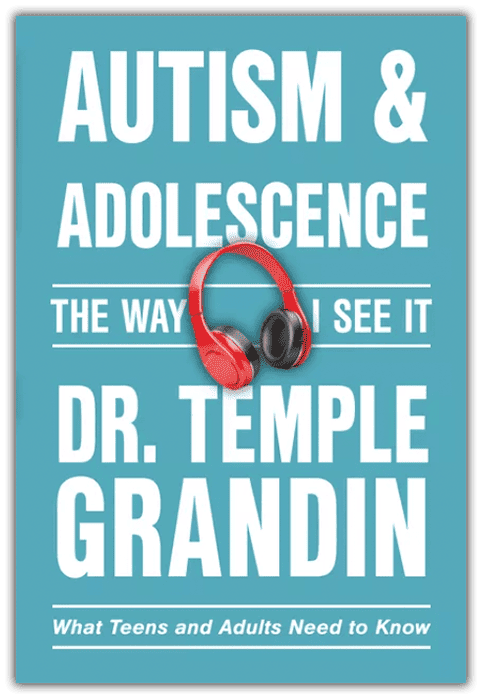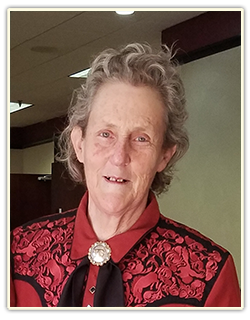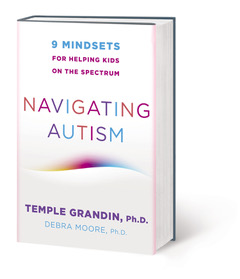
ASK TEMPLE!
Click "Ask Temple" to submit a question and it will be sent to Temple! She will answer as many as she can.
Webinars & Conferences
Upcoming Conferences
July 29 - Aurora, CO
August 14 - Hershey, PA
August 18 - Webinar
August 20 - New Orleans, LA
August 23 - Attica, MI
September 10 - Dallas Forth Worth
September 11 - Knoxville, TN
September 15 - Missoula, MT
September 19 - Cincinnati, OH
November 19 - Memphis, TN
November 20 - Jonesboro, AR
Temple's Latest Books!
Don't Miss This!
Visual Thinking
A MUST LISTEN!!
Temple Grandin earns Dole Leadership Prize!
NAVIGATING AUTISM
"The Outdoor Scientist"
Temple has been honored with a sculpture housed within the JBS Global Food Innovation Center on the Colorado State University Campus.

Temple comments:
“I think what’s really important is inspiring students to persevere,” said Grandin at a recent celebration for the bronze sculpture.
Grandin, a CSU professor of animal sciences and renowned animal behaviorist and autism activist, recalled just how important that trait was during her early years in the industry.
The artist, David Anderson, said, “We hope that this display will not only honor Dr. Grandin, but help expand the impact that she has had on the welfare of livestock and the understanding of autism
1950’s Methods For Teaching
Social Skills That Worked for Me
- By Temple Grandin
When I was in elementary school during the 1950’s all children were taught basic social skills the same way. When I visited a friend’s house and I made a table manners mistake, I was corrected by my friend’s mother. The methods and rules were the same at home, at the neighbors, and at school. All corrections were calm. There was no screaming or yelling.
1. Use Teachable Moments – When a mistake in social manners is made, never scream “NO, stop it, quit it or cut it out.” Instead give the instruction on a calm voice. Some examples are:
- Eating mashed potatoes with my hands – RESPONSE – Use your fork.
- Wiping my mouth with my hand – RESPONSE – Use your napkin.
- I forgot to s ay please or thank you – RESPONSE – You forgot to say ___.
- Stuck my tongue out at a person – RESPONSE – Put tongue back in your mouth – that is rude behavior.
2. Most important skills taught under age 8.
- Learning how to take turns. This was taught with a board game. When I got a little older, the whole family played cards. Lessons learned from turn taking in board games can be applied to taking turns doing activities as a family. When the family went to a movie, I had to take turns with my sister picking the movie. Another example would be choosing a restaurant or a store to visit.
- Saying please and thank you.
- Shaking hands and greeting people. It was demonstrated like teaching a person in a foreign country how to behave. Mother and teachers demonstrated the correct distance, looking in the eye and the amount of hand pressure. I practiced my skills by being party hostess when my mother invited guests for dinner.
- Shopping and learning the value of money. I got 50 cents a week to buy things I wanted such as comics, balsa wood toy airplanes, kites, and ice cream bars. These were items that if I wanted them I had to buy them myself. I also had to do all the interactions with the store staff. Mom stayed away when I made my purchases. My favorite toy airplane cost 69 cents so I had to have two weeks of allowance to buy it. Comics were 10 cents and a kite and string was 20 cents. Today these prices would be higher but I learned the value of money from my purchases. I also learned that I had to wait and save to get the 69 cent airplane.
- My ability in art was always encouraged. My teachers and mother encouraged me to draw many different things.
3. Excessive praise is bad - When I was very young, Applied Behavior Analysis (ABA) methods were used to teach me to talk and lots of praise was used. This was required to get my speech started. By age four I had learned to talk and ABA methods were phased out. After I learned to talk, constant praise was stopped. Praise was reserved for something really special such as a really fabulous art project or singing at a concert. The following activities and behaviors were not praised. In the 1950’s, children were expected to do the following. This may not work for a nonverbal child.
- Be on time for meals, religious workshop or school bus pickup.
- Making my bed.
- Dressing myself. Before I went to bed, I was taught to lay out the clothes I was going to wear the next day. I started to do this at age five.
- Getting up on time.
- Being polite.
Saying please when making a request and thanking another person for doing something I requested was always emphasized. In many situations, saying thank you was a form of praise. At the dining room table, my sister would ask me to pass the serving dish of green beans. When I passed it, she said thank you. To effectively teach children the parents also have to practice good manners and say please and thank you.
4. Temper Tantrums- When I had a temper tantrum at home or at school the penalty was no TV for one night. Mother and my elementary school teachers worked as a team. If I had a temper tantrum at home, she put me in my room and let me scream it out. Thirty minutes later when I was calm, she invited me back to join the family, but there was no TV tonight. Mother always handled it calmly.
4. Oppositional Behavior - Provide choices to help prevent oppositional behavior where a child always says No. Below are some examples:
- You can do your homework either after school or after dinner
- You can wear your blue shirt or your white one. I was allowed to pick out the clothes I wanted to wear from the clothes that were in the drawer.
- Video game playing needs to be limited to one hour a day and two hours a day on weekends. Give the child a choice of activities they can do when they are not playing video games. They could choose between playing outside with kites and airplanes or adding to their rock collections. Both my sister and I had extensive rock collections that we kept in the garage. I spent hours doing airplane and kite design experiments. We also did creative craft projects such as making abstract art by gluing painted pieces of pasta to cardboard. Another time, my sister and I decorated our trikes with gold paint.
Sensory Therapies and Autism
Autism and Sensory Issues often go hand-in-hand. It is common to have sensory issues that affect both behavior and perception. However, Sensory Processing disorders are not necessarily affected by Autism.
Many experts feel that the focus on sensory issues today is where the focus on autism was in the 90's. Sensory therapies are an evidence based treatment. Shoen et al (2018) A systematic review of Ayres. Sensory Integration Intervention for Children With Autism; Autism Research Vol 12. As the interest on autism has exploded since then, they believe that sensory challenges will become the primary focus in the future . . . even more emphasized than autism. Go to www.sensoryworld.com for more information.
There was a question submitted to Dr. Temple Grandin this past month from an individual researching to prove Sensory Therapies are crucial elements to improve the quality of life for children with ASD.
Below are the opinions of Temple in regards to Sensory Therapies.
Why is it important to consider sensory therapies?
For some individuals with autism, sensory therapies are very beneficial. Autism is highly variable and a sensory therapy that works well for one child may have no effect on another. Some of the most common sensory therapies are the use of deep pressure for calming, slow swinging, heavy work activities, and the brushing method. Sensory therapies performed by an occupational therapist can help some children to be calmer, more attentive and may aid in speech development.
How do you assess the sensory therapy a child needs?
Children who seek deep pressure by rolling up in blankets or who get under mattresses are the ones most likely to benefit from deep pressure. In small children, deep pressure can be easily applied by rolling a child in heavy mats or getting under bean bag chairs. In many individuals, the squeeze machine or other devices that apply pressure are calming. Deep pressure is most effective when it is applied for 20 minutes and then removed for 20 minutes. Kids that like to swing may benefit from it. Some children may be able to speak more easily while they are doing slow swinging or sitting balancing on an exercise ball. Weighted vests help some children and do not work for others.





